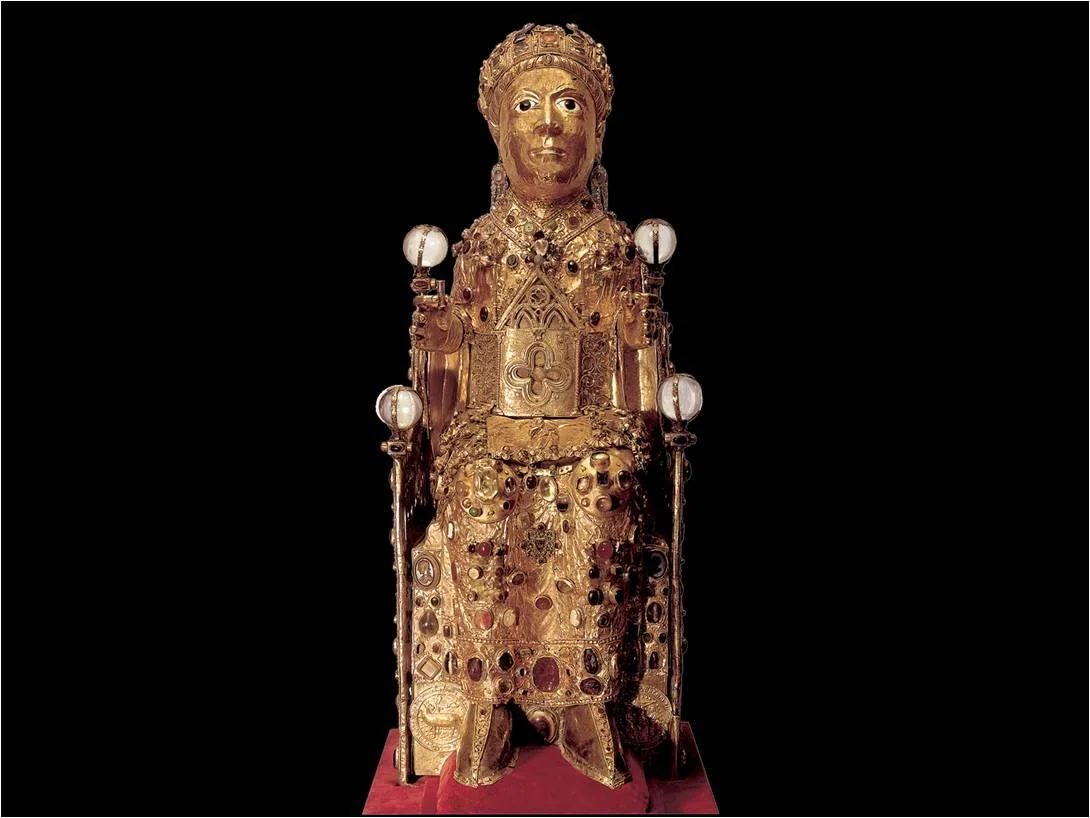The Cult Of Saints: Sainte Foy by Sydney K. Gobin
Divine rays of ethereal light stream through rich, multicolored glass; overwhelming scents are emitted from hanging lanterns, masking the indistinguishable mixture of odors brought into the sacred space; footsteps echo against the cavernous stone walls. Angels, demons, saints, and prophets peer downward imploring self-reflection and fear upon the visitors; recalling those they left behind and those who came before. Monopolizing the senses, the pilgrimage church served as an awe-inspiring symbol of the holy power which reigned supreme in France during the Middle Ages. These monumental stone institutions were part of a network of churches leading the penitent pilgrim along their treacherous journey of hope.
Cathedrals were erected by entire communities to commemorate the physical sacrifice linked to the religious standards imposed by the Christian elite. Each cathedral, an architectural stele, a praesentia* signifying a martyred saint, was strengthened by its proximity to heaven and Earth, loci. The Saints, sacrificed for their faith, are resurrected from martyrdom representing the possibility of eternal glory following an extraordinarily violent existence. Believing saints were corporally one with God and surrounded by peril, the superstitious sought security and comfort in their daily lives, often committing to the “therapy of distance,” thus permitting themselves to search outside of the immediate corporeal community.
Did you know…Prasentia relates to the viewer’s physical distance from the object, subsequently causing the rapidly increasing practice of pilgrimage. The concept of Roman memoriae links the practice of building cathedrals over tombs of martyred saints to pagan traditions.
Hagiographic Influences on the Practice of Pilgrimage
The Abbey Church of Sainte Foy at Conques is an excellent vehicle with which to examine the effects of hagiography on pilgrimages. While there are a multitude of collections celebrating sainted martyrs, Conques is unique in the fact that it is one of the finest examples of Romanesque architecture still intact. Scattered throughout France, pilgrimage churches relied profoundly upon devoted visitors willing to donate their limited valuables, coins, and time, in hopes for a miraculous intervention. This is especially true for the followers of Sainte Foy, who was believed to not only aid the sick, but raise the dead, and break the chains of the enslaved. Preying on superstition, monks and/or clerics convinced believers that, given a specified sum, they could purchase favors from the patron saint, in addition to their place at the right hand of Christ, avoiding the torments of the underworld. However, what is perhaps more intriguing is not the inspiration behind the pilgrimages, but rather the reliquary treasures they produced and displayed in order to entice devotees. Products of faith, the iconography and mastery behind the existing artistic remnants, employed the connections of religious society to its visual productions. The reliquary of Sainte Foy at Conques is perhaps one of the most powerful of these treasures.
St. Foy in Majesty. c. 980. Location: Conques, Trésor de l’abbatiale Sainte-Foy de Conques. Wikimedia Commons.
It is the abbey church name-sake relic that captures true devotion as practiced by the phenomenon of the cult of saints, which resulted in the public orchestration of ceremony and pilgrimage. Centered at Conques, the cult of Sainte Foy was based upon a young girl from Aquitaine, who was tortured and beheaded for refusing to make pagan sacrifices under the Roman persecution of Christians at the end of the third century. Serving as one of the main reasons for pilgrimage, hagiography flourished after relics were given places upon the altars in the eighth century, increasing the number of viewers, and grew further in the twelfth century when many saints were formally canonized. As spiritual crusaders, pilgrims risked the treacherous journey for the spiritual fulfillment received from great relics, like that of Sainte Foy in Majesty (above). Originating in the ninth century, the cult of Sainte Foy immortalized Conques—as it grew, providing a place for relics to be gathered, while reflecting the passion of the era.
Demanding Tribute: The Power of Sainte Foy
The relic of Sainte Foy was amongst the most powerful in the region, maintaining the ability to not only heal the sick (primarily eyesight, including restoring the vision of a man who had his eyes gouged out) but could raise the dead, and break the chains of the enslaved. Her many miracles, not always positive and sometimes even violent, are outlined in the Book of Sainte Foy’s Miracles. The text was composed by a number of eleventh-century figures, most notably Bernard of Angers, who himself journeyed to Conques on three separate occasions and gathered a collection of forty-nine accounts of miracles which comprise in the first two chapters of the text. The accounts of the life and death of Sainte Foy widely varied and expanded as time went on, thus the significance of her relic and Conques grew accordingly. Subsequently, Sainte Foy required ample tribute for her miracles, demanding whatever treasure the pilgrims possessed. Freed slaves were expected to offer the iron chains that bound them so they could be repurposed into decorative grilles and doors, supporting Foy’s glory. In turn, she would punish those that wronged her or her protectors, haunting them through visions until order was restored; as was the case when an unsuspecting man pocketed the excess gold intended for her reliquary. In addition to haunting her wrongdoers until they relented to her will, her spirit was also known to cause physical harm, and even death, to those who chose to disobey.
Nestled in a shell-like belvedere in Southern France, the Abbey Church of Sainte Foy was originally founded by fleeing monks hoping to escape the Saracens in Spain, in the eighth century. Desperate to put the site at Conques on the lucrative pilgrimage route, many attempts were made to acquire some sort of relic. These attempts were not always committed in the most Christian ways, but rather through deception and theft. However, this was not uncommon as it was believed that the reliquary of a Saint could not be taken without their permission; therefore, the successful move was described as having been translated (translatio) and proved the willingness of the Saint to relocate. After multiple failed attempts trying to steal the relics of Saint Vincent of Saragossa (†304) and Saint Vincent Pompejac in Agen, the monks of Conques succeeded in 866 with the retrieval of the head of Sainte Foy. This acquisition not only shifted the pilgrimage site of Sainte Foy from Agen to Conques, but solidified the structure as a stop on the way to Santiago de Compostela in nearby Spain. In the eleventh century, the church at Conques was enlarged to accommodate the massive influx of pilgrims coming to honor the bones of Sainte Foy.
Detail of the Tympan du Jugement on the exterior of the Abbey of Sainte-Foy. By Jean-Louis Zimmerman via Flikr.
Romanesque Glory
Erected as the only stone structure in the area, the abbey church personified the significance of the pilgrimage. Relatively small in scale in comparison to its contemporaries, the structure exhibits truly defining Romanesque characteristics: Three majestic towers project into the heavens atop a single, two-part elevation, and a barrel-vaulted nave culminating with chapels radiating from its east end. Although its remote location prohibited the grandeur of monumental scale, its environment enhanced the opulence and wonder felt by the devotees as Conques emerged before them, seemingly out of nowhere. As the purses of the church grew due to the miracles of Sainte Foy, so did the treasury at the abbey church. Boasting decadent items festooned with rare jewels and an excess of gold, each object further punctuated the idea of the divine. Though most of these objects adopted the reliquary role, reminders of constant protection, others were crafted in the form of statuettes, book covers, and enamels, among an array of others.
Ultimately, it is Sainte Foy in Majesty (ninth century and later) that received the most attention from the abbey church’s inhabitants because of the wondrous, aforementioned miracles that she performed. Seated on a throne, the saint of faith gazes outward, unscathed from her sacrifice, her arms reach outwards holding between her thumb and forefinger two small cylinders. The female child-martyr appears with the head of an adult man, a repurposed fragment from late antiquity. Her chest, adorned with a chapel-façade, featuring a large quatrefoil in the center, and surmounted with a pair of pointed arches below a rose window. Sheathed in gold, and encrusted with precious gems, including intaglio cameos upon her throne and four large crystal spheres framing her form, the relic must have appeared transcendent from the earthly realm, glistening in the candlelight and enhanced by her stone surroundings. Adhering to the theory that the more elaborate the reliquary is, the more significant the relic is within: the reliquary becomes a relic itself.
Yearning for an escape, devotees clung to what hope they could find, eliciting “invisible companions,” most typically saints that would serve as guides through the crushing weight of holiness. Saints served as examples of those who had successfully achieved donim perseverantia. Augustine of Hippo (354-430) speaks of the sacrifice of martyrdom:
They really love this life; yet they weighed it up. They thought of how much they should love the things eternal if they were capable of such deep love for things that pass away.
Celebrated statements such as these increased the practice of pilgrimage through the Cult of Saints and the need for hope among the medieval people.
Gaining power as generations passed, the growth of the cult of saints and power of holy relics was rooted in nostalgia. The idea of an attached community linked by the “imaginative memory” of believers produced legends. Instilling absolute faith in the church, and aided in the use of reliquaries and the miracles they produced, holy leaders, in turn, pressured themselves to keep up their facilities to accommodate for the massive number of worshipers drawn to their sanctuary. The cult of saints, and Sainte Foy herself, relied on devout believers to participate in the epic journey of hope in order to maintain their power. Sacrificed for their beliefs, and resurrected from martyrdom, the Saints represented the possibility of eternal glory following an extraordinarily violent existence, and thus demanded the tribute appropriate to their status. The reliquaries and the remains, like those of Sainte Foy, demonstrate the power and the religious drive associated with mass pilgrimage.
Sydney is a Medieval Art Historian and Archivist based in Brooklyn, NY. She received her master’s degrees from The Pratt Institute in the History of Art and Design and Library and Information Science, with an advanced certificate in Archives; her undergraduate degree is also in the History of Art and Design, with a concentration in Medieval and Renaissance art, from Purdue University. Sydney is passionate about artistic culture during the middle ages -- specifically within manuscript illumination -- and the exchange of ideas which they represent. When she’s not focusing on academic pursuits, she can be found visiting museums, traveling, and getting lost in Middle Earth. Sydney currently works as a Data Technician while moonlighting as an Archivist and Collection Manager for artists and art historians in the Greater New York Area. You can follow her on Instagram: @artventurous
This article was originally featured in our Hagiography Issue. Get the entire issue here: The Medieval Magazine - Hagiography



